
Some people who are on certain medications need regular testing (called monitoring) as they are at risk of damage to the eye. The tests will check for any damage, and you may have to change your medication.
Everyone from the age of 12 who has diabetes will be invited to have pictures taken of their eyes at least once a year. This is to check for damage to the back of your eye caused by the diabetes. The service is called diabetic eye screening and is provided for people in West Yorkshire by:
- Leeds and Mid Yorkshire Diabetic Eye Screening Programme
- West Riding and Craven Diabetic Eye Screening Programme
Damage to the eye caused by diabetes is called ‘diabetic retinopathy’. This can often start before you get any changes to your vision so it is important to attend for screening if you are invited.
At the screening, you will have eye drops put into your eyes to make your pupils bigger. This will make your eyesight blurry and more sensitive to light for a few hours. This means you cannot drive for a while so you will need to find a way to get to and from your appointment. It may be helpful to have a friend or family member come to the screening with you or pick you up afterwards.
You will have a vision test as part of the screening appointment. Bring your glasses or contact lenses (and solution) with you. This test is for best ‘corrected’ vision which means you are tested wearing your glasses or contact lenses.
You will then be given the eye drops and asked to wait. Once the drops have worked, you will be called through to see a photographer who will take some photographs of the back of your eyes. These photographs are then assessed and you will get the results in the post in about six weeks.
Your results will either tell you:
- You have no changes. You will be seen again in one to two years.
- You have some changes. This is called ‘background retinopathy’ where there are small changes to the back of your eye due to diabetes. This will not be affecting your vision at this time and requires no treatment. You will be seen again in a year.
- Eye damage that could affect your sight. This is called ‘referable retinopathy’ which means the damage to your eyes is more significant. You may need treatment, further screening or an appointment to see a specialist. You will be given more information about the next steps.
The NHS has more information about diabetic eye screening and diabetic retinopathy on its website.
This video from Essex Diabetic Eye Screening programme has real patients talking about their experiences with diabetic eye problems and screening.
This video from Birmingham, Solihull and Black Country Diabetic Eye Screening Programme explains the screening process. It also has links to multi language versions.

People who take hydroxychloroquine for more than five years, or in high doses, are at increased risk of damage to the back of the eye. This damage, especially in the central area of the vision called the macula, causes significant and irreversible sight loss.
For this reason, the NHS now offers regular monitoring for patients who take hydroxychloroquine. Some images and scans will be taken of your eye and checked for any damage. This leaflet has been produced to provide further information for patients taking hydroxychloroquine.
Patients who are referred to the hospital for raised eye pressure are sometimes diagnosed with glaucoma, but many others are diagnosed with ocular hypertension. These patients are often monitored by the hospital but are sometimes monitored by a specialist optometrist at an opticians as part of an ocular hypertension monitoring service.
Children usually have a free eye test when they start school at 4 or 5 years old. For more details about the local school vision screening programme please see the children’s eye health page.
